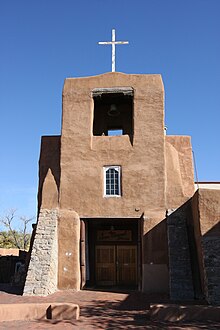
Mission San Buenaventura, formally known as the Mission Basilica of San Buenaventura, is a Catholic parish and basilica in the Archdiocese of Los Angeles. The parish church in the city of Ventura, California, United States, is a Spanish mission founded by the Order of Friars Minor. Founded on March 31, 1782, it was the ninth Spanish mission established in Alta California and the last to be established by the head of the Franciscan missions in California, Junípero Serra. Designated a California Historical Landmark, the mission is one of many locally designated landmarks in downtown Ventura.
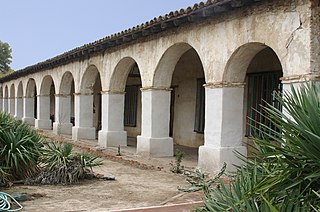
Mission San Miguel Arcángel is a Spanish mission in San Miguel, California. It was established on July 25, 1797, by the Franciscan order, on a site chosen specifically due to the large number of Salinan Indians that inhabited the area, whom the Spanish priests wanted to evangelize.

A reredos is a large altarpiece, a screen, or decoration placed behind the altar in a church. It often includes religious images.
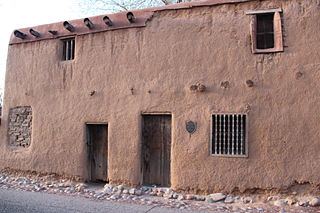
The De Vargas Street House, often referred to as the Oldest House, is a historic building in Santa Fe, New Mexico, which is often said to be one of the oldest buildings in United States. The original date of construction is unknown but the majority of the building is believed to date to the Spanish colonial period (post-1610). One archaeological study also concluded that some sections of the walls are characteristic of Pueblo architecture and may be pre-Spanish in origin. The building was listed on the National Register of Historic Places and New Mexico State Register of Cultural Properties in 1968 as a contributing property in the Barrio De Analco Historic District.

San Felipe de Neri Church is a historic Catholic church located on the north side of Old Town Plaza in Albuquerque, New Mexico. Built in 1793, it is one of the oldest surviving buildings in the city and the only building in Old Town proven to date to the Spanish colonial period. The church is listed on the New Mexico State Register of Cultural Properties and the National Register of Historic Places and has remained in continuous use for over 200 years.

El Santuario de Chimayó is a Roman Catholic church in Chimayo, New Mexico, United States. This shrine, a National Historic Landmark, is famous for the story of its founding and as a contemporary pilgrimage site. It receives almost 300,000 visitors per year and has been called "no doubt the most important Catholic pilgrimage center in the United States."

The Cathedral Basilica of Saint Francis of Assisi, commonly known as Saint Francis Cathedral, is a Roman Catholic cathedral in downtown Santa Fe, New Mexico. It is the mother church of the Archdiocese of Santa Fe.

St. Michael's High School is a private Catholic junior/senior high school located in Santa Fe, New Mexico. It is privately run under the auspices of the international Institute of the Brothers of the Christian Schools, better known as the De La Salle Christian Brothers.

The Barrio de Analco Historic District is a National Historic Landmark District centered at the junction of East De Vargas Street and Old Santa Fe Trail in Santa Fe, New Mexico. The seven buildings of the district represent one of the oldest clusters of what were basically working-class or lower-class residences in North America, and are in a cross-section of pre-statehood architectural styles. It includes two of the oldest colonial-era buildings in the southwest, the San Miguel Mission church (1710), and the "Oldest House", built in 1620 and now a museum. The district was declared a National Historic Landmark in 1968.

San Estévan del Rey Mission Church is a Spanish mission church in the Roman Catholic Diocese of Gallup on the Acoma Pueblo Reservation in western New Mexico. Built between 1629 and 1641, it is one of the finest extant examples of hybrid Spanish Colonial and Puebloan architectural styles. It was named for Saint Stephen I of Hungary. The church was declared a National Historic Landmark in 1970, and is listed on the National Register of Historic Places. It remains a mission church and is part of the parish of San José de la Laguna in Laguna, New Mexico.
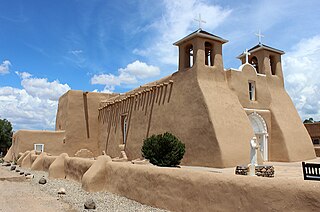
San Francisco de Asís Mission Church is a historic and architecturally significant building on the main plaza of Ranchos de Taos, New Mexico. Originally the center of a small Mexican and Indian 18th Century agricultural community. Built between 1772 and 1816 replacing an earlier church in that location. New Mexico was then part of the Vice-Royalty of New Spain. It is a fine example of a New Mexico Spanish Colonial Church, and is a popular subject for artists. It was designated a National Historic Landmark in 1970. It is a parish church of the Roman Catholic Archdiocese of Santa Fe.

All Hallows Twickenham is a Grade I listed church and parish of the Church of England in Twickenham, London. It incorporates the tower of All Hallows Lombard Street and is prominently south of a major road of west London, near Twickenham Stadium, specifically the Chertsey Road (A316).

San Pedro Cholula is a municipality in the Mexican state of Puebla and one of two municipalities which made up the city of Cholula. The city has been divided into two sections since the pre Hispanic era, when revolting Toltec-Chichimecas pushed the formerly dominant Olmec-Xicallanca to the eastern side of the city in the 13th century. The new lords called themselves Cholutecas and built a new temple to Quetzalcoatl on the San Pedro side, which eventually eclipsed the formerly prominent Great Pyramid of Cholula, now on the San Andrés side. When the Spanish arrived in the 16th century, the city of Cholula was an important religious and economic center, but the center of power was on the San Pedro side, centered on what is now the main city plaza and the San Gabriel monastery. The division of the city persisted and San Pedro remained the more dominant, with Spanish families moving onto that side and the rest of the population quickly becoming mestizo. Today, San Pedro is still more commercial and less residential than neighboring San Andrés with most of its population employed in industry, commerce and services rather than agriculture. Although Cholula's main tourist attraction, the Pyramid, is in San Andrés, San Pedro has more tourism infrastructure such as hotels, restaurants and bars.
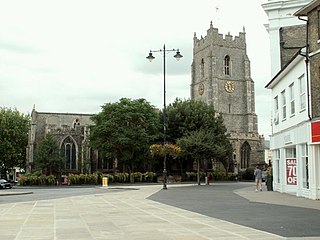
St Peter'sChurch, Sudbury is a former Anglican church in the town of Sudbury, Suffolk, England, which now serves as an Arts Centre. The building is recorded in the National Heritage List for England as a designated Grade I listed building, and is under the care of the Churches Conservation Trust. The building stands in the heart of the town in a dominating position on Market Hill.

The Parroquia de Santa Prisca y San Sebastían, commonly known as the Church of Santa Prisca, is a colonial monument located in the city of Taxco de Alarcón, in the southern state of Guerrero, Mexico, built between 1751 and 1759. It is located on the east side of the main plaza of Taxco.

The Reredos of Our Lady of Light is a historic stone reredos carved in 1761 in Santa Fe, New Mexico. It was originally installed in the Chapel of Our Lady of Light on the Plaza and is presently housed in Cristo Rey Church, which was built for that purpose in 1940. Described as "the only one of its kind from the Spanish period in the United States" and "definitely one of the most extraordinary pieces of ecclesiastical art in the country", it was added to the National Register of Historic Places in 1970.

The Santa Monica Parish Church, commonly known as the Minalin Church, is a Baroque Roman Catholic church, located in poblacion area of San Nicolas in Minalin, Pampanga, Philippines. The church, built during the Spanish era, was declared a National Cultural Treasure by the National Commission for Culture and the Arts and the National Museum of the Philippines on August 27, 2011, one of 37 churches in the country bestowed that honor.

St. Jerome Parish Church is a Roman Catholic church located in Morong, Rizal, Philippines. It was built during the Spanish period in the country, with stones from a hill called Kay Ngaya; lime from the stones of the mountain Kay Maputi; and sand and gravel from Morong River.

The Lamy Building, also known as St. Michael's Dormitory, is a historic building in Santa Fe, New Mexico. It was built in 1878 as the main building of St. Michael's College, the predecessor of St. Michael's High School and the College of Santa Fe. The building is a contributing property in the Barrio De Analco Historic District and currently serves as the headquarters of the New Mexico Tourism Department.

Cristo Rey Church is a Roman Catholic parish church on Canyon Road in Santa Fe, New Mexico. It is one of the most notable buildings designed by influential Santa Fe architect John Gaw Meem and is claimed by some sources to be the largest adobe building in the United States. It is also notable for its historic altar screen, the Reredos of Our Lady of Light, which is listed on the National Register of Historic Places. The reredos was carved in 1761 and originally hung in La Castrense, a military chapel on the Santa Fe Plaza. It has been described as "one of the most extraordinary pieces of ecclesiastical art in the country". The church was dedicated in 1940.
